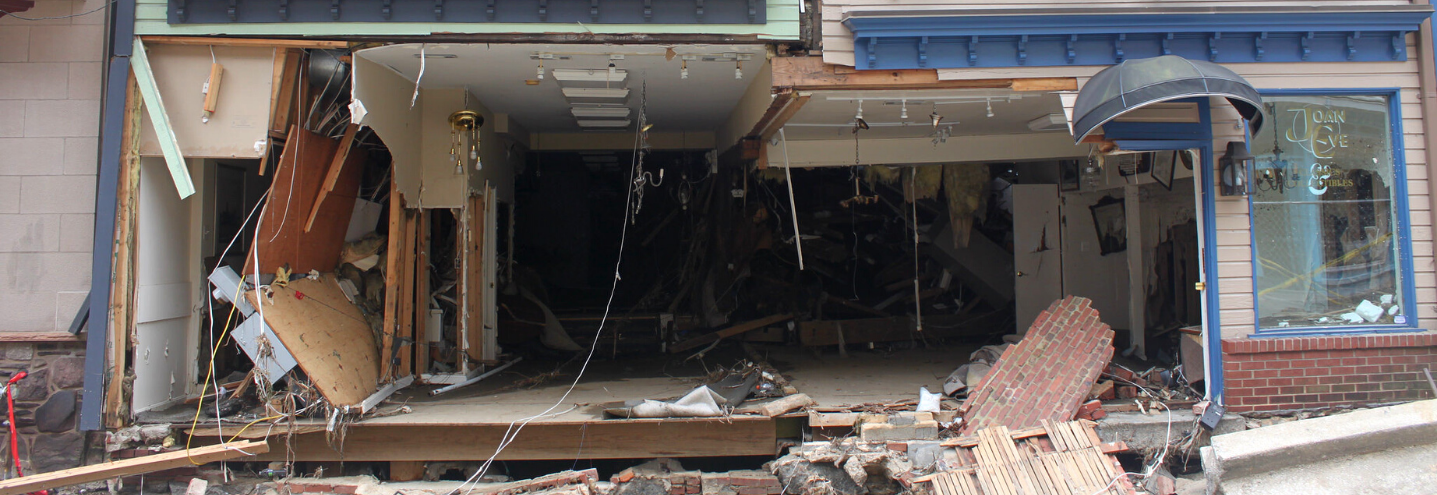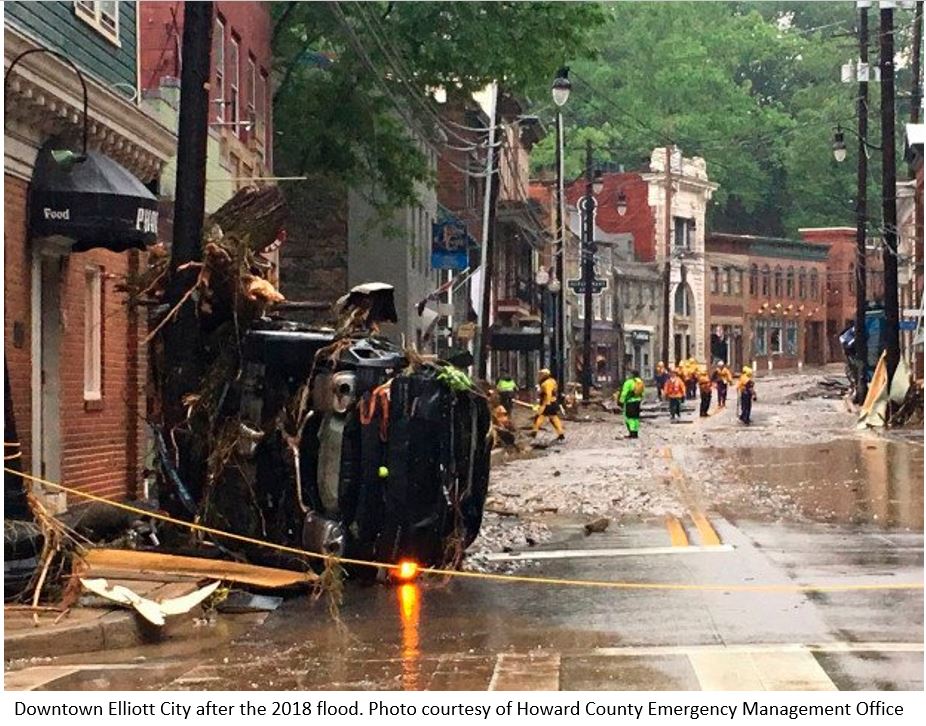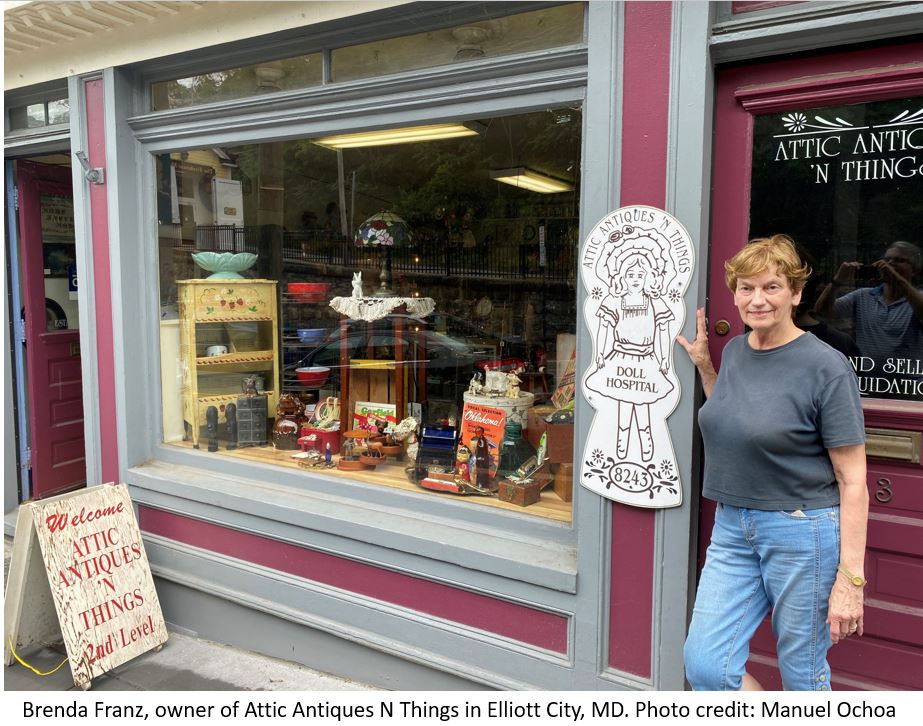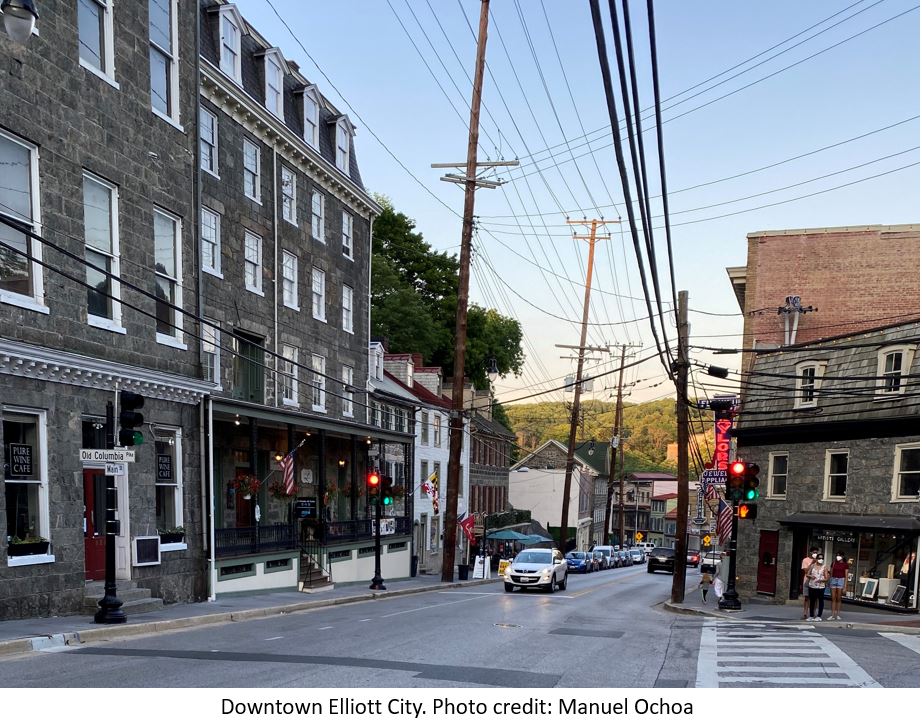
Recently, on a rainy summer afternoon, I visited Ellicott City, Maryland, with my family. I had just landed at BWI Airport, so this was the perfect opportunity to grab dinner and check out a town I had heard so much about. Founded by Quakers in 1772, Ellicott City was built at the confluence of the Tiber and Patapsco rivers as a mill town. One of the most prosperous mills on the East Coast, Ellicott City also boasts the oldest surviving train station, a National Historic Landmark, in the U.S. Today, Ellicott City is a picture-perfect Main Street community with a bustling downtown, babbling creek, and solid, historic stone storefronts. It’s hard to believe that the town has been devastated by flooding in 2016 and 2018.
After having dinner at a tavern, my family and I were eager to check out the mix of unique shops downtown. What we didn’t bank on was a post-dinner workout, climbing and descending Ellicott City’s steep hills. Making our way up a hill, I stopped to look inside an antique shop called Attic Antiques N Things. After chatting with the business owner, Brenda Franz, my eyes wandered to articles and photos that hung near her office, showing a flooded street and the business’ scoured storefront standing precipitously over a 10-foot drop. I was surprised and amazed by what I saw: How could a store at the top of a hill be so devastated when the river is almost 100 feet below?
Two 500-year Floods Hit Ellicott City

Brenda shared her story. On October 6, 2016, a strong line of thunderstorms dumped six inches of rain in two hours. A flash flood funneled a rushing wall of water down Main Street from the many hilly streets and ridges around town. At the time of the storm, Brenda was in the store and witnessed the three-foot river of water shake her storefront. Luckily, Brenda was safe, but others were swept away, resulting in two deaths. The flood not only wreaked havoc on her store, but also her basement. Over 30 years of merchandise— mostly antiques and one-of-a-kind items—were damaged beyond repair.
The town had never experienced a flood like this before. Usually, the flood danger was a quarter of a mile away at the river. This kind of flooding near the top of a hill was never considered in the realm of possibility, so much so that even Brenda’s insurance agent told her she didn’t need flood insurance. As Brenda explained, the 30-year-urbanization of Howard County had precipitated the flood risk. More development creates more impervious surfaces where the land no longer absorbs water, but rather travels on asphalt and pavement at greater speeds as it goes downhill. When a freak rainstorm’s microburst dumps its water in one place with those impervious surfaces, you get what meteorologists call a “500-year flood.”
So then, how is it that the 500-year flood occurred again only two years later, in May of 2018? One term: climate change. Logically, we don’t expect that these events are going to be spaced exactly 500 years apart, but they are certainly not supposed to occur within two years.
Preparing Main Street Leaders for the Impacts of Climate Change
Brenda’s story raises a myriad of questions for Main Street communities. How can downtowns and commercial districts prepare for increasing climate change impacts, particularly natural disasters like the flooding in Ellicott City? How can we help communities lower their risk along the way? Answering those questions is the goal of a unique partnership between the National Park Service (NPS) and Main Street America (MSA): the National Park Service Main Street Community Disaster Preparedness and Resilience Program.

Through this program funded through the Historic Preservation Fund Emergency Supplemental Historic Preservation Fund (ESHPF) administered through the National Park Service, MSA will create a suite of resources that help Main Street organizations prepare for and respond to catastrophic events. While many disaster preparedness kits and plans exist, none of them are specifically tailored for Main Street communities or commercial district leaders. The Main Street Community Disaster Preparedness and Resilience program is meant to address that by developing tools specifically designed for the unique needs of commercial districts.
Over the next several years, MSA will convene experts and stakeholders, create a clearinghouse of curated resources, develop a toolkit with strategies and worksheets for the most frequent disasters, and hold workshops and trainings related to disaster preparedness and resilience.
As part of our three-year program, we will learn how disasters affect Main Street communities, local economies, and historic resources, and how these disasters impact community health, culture, and equity.
A year into the program, MSA has organized three national workshops in September 2020, October 2020 (as part of the PastForward Conference) and in April 2021, as part of the 2021 Main Street Now Conference. Over the next eighteen months, we will host up to six regional workshops where we will learn more about specific kinds of disasters and their various impacts, visit a community or a region in recovery, and present hands-on training.
Our next step is to develop a digital toolkit that will provide training materials, guidance on creating a disaster preparedness plan, and case studies. Additionally, this toolkit will include:
- Communications guidance to help leaders facilitate difficult conversations where “climate change” can be viewed as a bad word.
- Exploring the best and the worst-case scenarios of what might happen in a downtown and how to be ready for it.
- A diagnostic tool, offering a quick assessment and overall checklist with all the steps to prepare your downtown for the next disaster.

While the ESHPF funding focuses on states, tribes, and territories affected by Presidentially declared disasters including Hurricanes Harvey, Irma, Maria, Florence, and Michael and Typhoon Yutu (Alabama, the Commonwealth of the Northern Mariana Islands, the Coushatta Tribe of Louisiana, Florida, Georgia, Louisiana, North Carolina, Puerto Rico, the Seminole Tribe of Florida, South Carolina, Texas, the U.S. Virgin Islands, and Virginia), the resources produced through the Main Street Community Disaster Preparedness and Resilience Program will be available to commercial district leaders across the country.
Through our program’s Advisory Committee, we are collaborating with other national organizations such as the Housing Assistance Council, Enterprise Community Partners, Local Initiatives Support Corporation, the National Association for Latino Community Asset Builders, and the Urban Land Institute. Main Street state coordinators from Florida, Louisiana, and Texas also serve on this committee, and we are developing relationships with federal agencies at the forefront of disaster resilience, like FEMA. These organizations are sharing their expertise, experience, and resources to make this program as comprehensive and equitable as possible.
While we are often overwhelmed by the devastation communities like Ellicott City have experienced, we are also heartened by the resilience of this community to rebuild again (and again). We know disasters will happen, now with more frequency. The key is to ensure we can better prepare Main Street communities with the tools to face the next disaster and bounce back more quickly. Through the partnership with NPS and through the Main Street Community Disaster Preparedness and Resilience Program, MSA hopes to do just that.